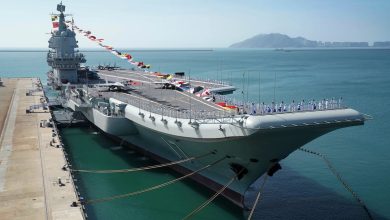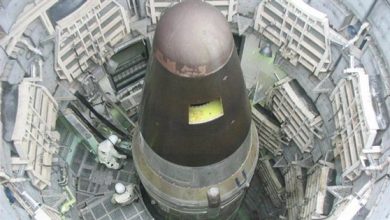Australian navy sizes up high-risk submarine transitions under AUKUS

SYDNEY — Australia has its work cut out keeping aging Collins-class diesel-electric submarines in service as it transitions to nuclear-powered submarines, firstly to second-hand Virginia-class boats from the United States, and then to SSN-AUKUS submarines designed and built in conjunction with the U.K.
Asked about the risks for the Collins-class life extension and the SSN programs, Rear Adm. Stephen Hughes, head of naval capability for the Royal Australian Navy (RAN), said he holds a “half-glass-full view” about the path ahead. “There are always the naysayers, but you’ve got to remember we’re pretty focused on delivering both outcomes.”
Hughes spoke to Defense News at the Indo-Pacific 2025 naval exhibition, held in Sydney from Nov. 4-6.
“Are they high risk? Sure – schedules, demanding technologies, the workforce is demanding,” he added. “I can list all the things that could go wrong, but one thing we’re really good at in Defence, despite maybe some other commentators’ views, is we’re really good at risk management.”
Defense officials have taken an “integrated approach” to orchestrating the two programs, from legacy submarines to nuclear-powered boats, which puts the spotlight on getting the transition right, he said.
Australian industry excitement
Much attention was paid at the Indo-Pacific 2025 event here to agreements over potential involvement in the SSN-AUKUS submarine program. One announcements was about a teaming arrangement on Nov. 5 by four major primes to compete for the SSN-AUKUS combat system.
The team comprises BAE Systems, General Dynamics Mission Systems, Raytheon Australia and Thales. The quartet stated they would design a trinational command system as a “shared solution for Australia and the U.K.,” building on General Dynamics’ existing AN/BYG-1 system.
Incidentally, the AN/BYG-1 is already installed on Australia’s six Collins-class submarines.
Another announcement on Nov. 4 covered a strategic agreement paving the way for South Australian firm PMB Defence to supply nickel zinc batteries. PMB Defence is working with BAE Systems, designer of the SSN-AUKUS boat, to enable potential integration of its batteries. Contracts between the two are already valued in excess of $22 million.
Certifiable progress
With Australian companies hoping to seize a slice of the submarine pie, the Australian navy remains optimistic of the capability it will obtain.
“My view is, based on what Trump said publicly, he’s committed to the AUKUS program,” said Hughes, referring to U.S. President Donald Trump, whose government had initiated a review of the tri-national program. “We’re investing in the U.S. industry base, the U.S. is driven to ensuring we have the best capability, because it’s in their benefit to have us with a submarine that can survive in the future threat.”
HII and Babcock have joined forces to support the AUKUS submarine endeavor, creating a joint venture called H&B Defence in June 2024. To qualify Australian businesses as suppliers for the U.S. nuclear submarine enterprise, it issued an expression of interest to which 378 Australian companies responded. A handful have already been validated against HHI’s standards.
Eric Chewning, HII’s executive vice president for maritime systems and corporate strategy, said the company has increased throughput at its shipyards by 15%.
“We’re continuing to hit that acceleration,” he said. “One of the important strategies we have to do that is the distributed shipbuilding model where we’re outsourcing.”
Industry experts have suggested that some bottlenecks in U.S. production could be alleviated by help from new Australian suppliers.
Meanwhile, Rolls-Royce, the only private company in the world producing nuclear reactors for submarines, is providing PWR3+ power plants for SSN-AUKUS boats.
Steve Carlier, Rolls-Royce Submarines president, told Defense News that the improved PWR3+ provides greater operational flexibility since it gives crews more options in how to use the energy, plus it brings greater safety levels.
Carlier also confirmed the SSN-AUKUS’s preliminary design review is expected to be achieved in September 2026.
Hughes confirmed the first Collins-class submarine, HMAS Farncomb, will enter a two-year life-of-type extension (LOTE) program next year. The effort is designed to stretch the life of boats by ten years, as the new SSN fleet is gradually slated to arrive.
Gordon Arthur is an Asia correspondent for Defense News. After a 20-year stint working in Hong Kong, he now resides in New Zealand. He has attended military exercises and defense exhibitions in about 20 countries around the Asia-Pacific region.







